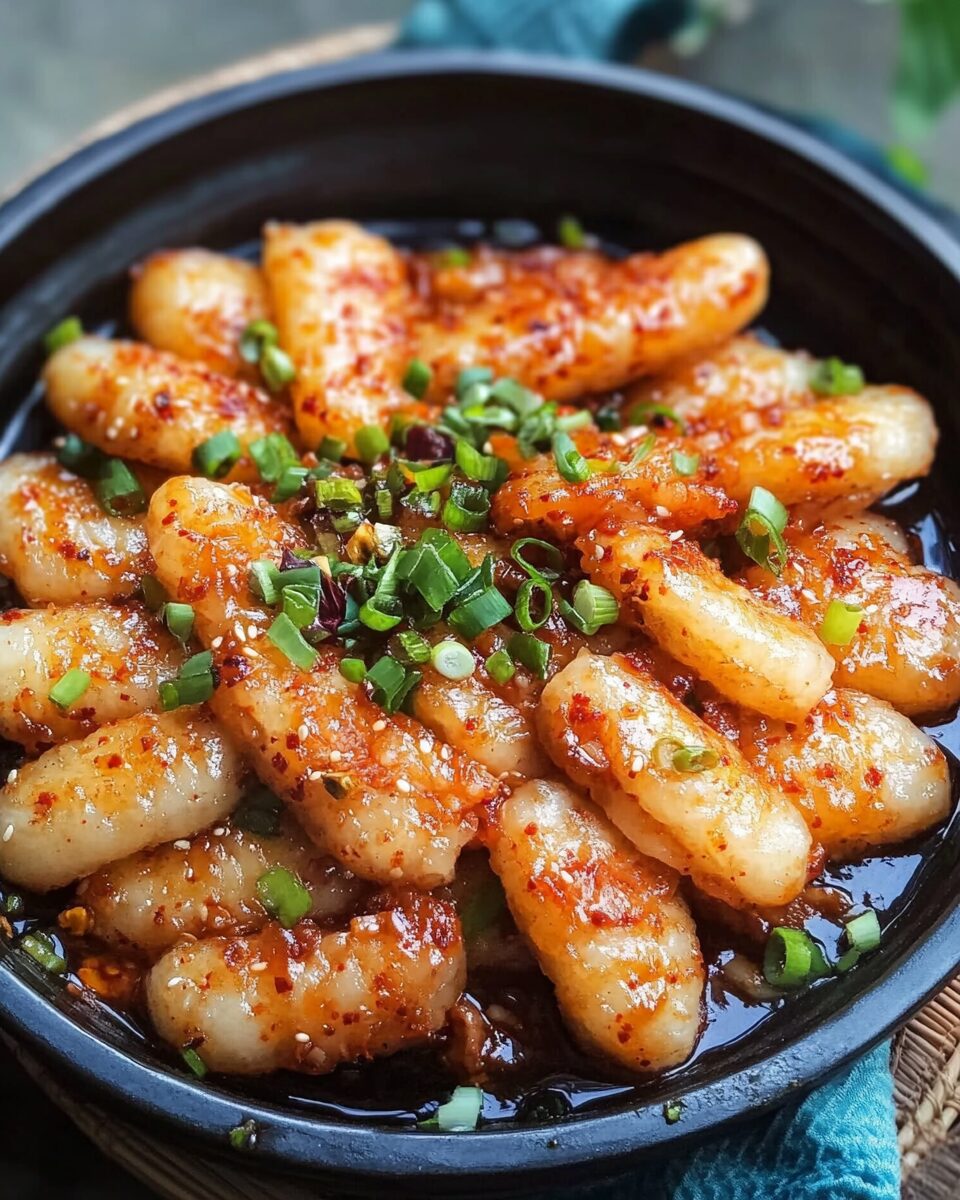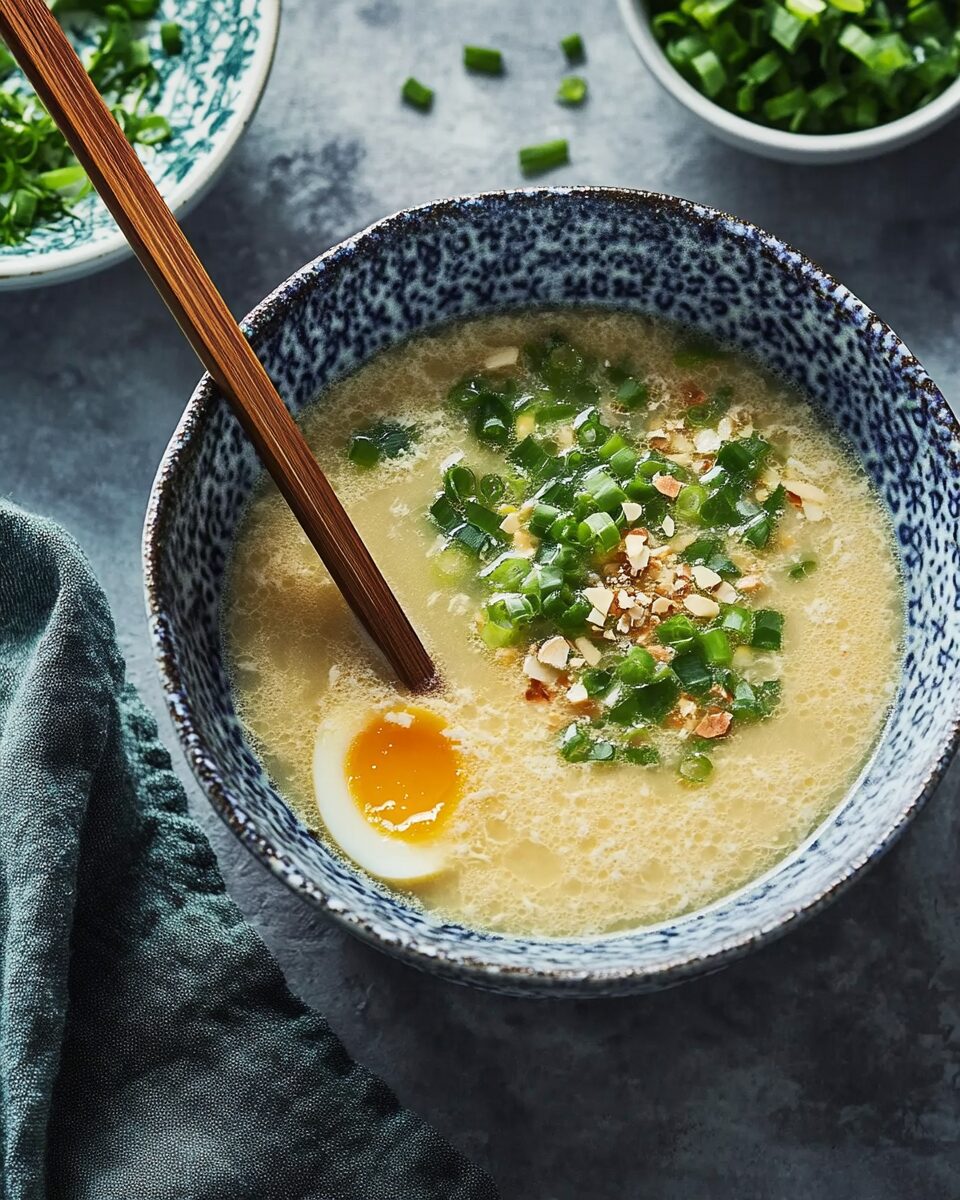Spicy Korean Rice Cakes, also known as Ddeokbokki or Tteokbokki, is a popular street food in South Korea that is both comforting and addictive. Made with chewy rice cakes, this dish features a spicy and savory sauce that’s packed with rich flavors. The dish is often served as a quick snack, a street food delight, or even as a full meal when paired with other ingredients like fish cakes and boiled eggs. The rice cakes absorb the bold and tangy sauce, creating a satisfying combination of textures and flavors. Whether you’re enjoying it on a busy street in Seoul or making it at home, Ddeokbokki brings a taste of Korean cuisine to your table that’s sure to satisfy your craving for something spicy and savory.
Full Recipe:
Ingredients
- 1 lb (450g) Korean rice cakes (tteok)
- 2 tablespoons vegetable oil
- 1/2 onion, sliced
- 2 cloves garlic, minced
- 2 tablespoons gochujang (Korean red chili paste)
- 1 tablespoon gochugaru (Korean red pepper flakes)
- 1 tablespoon soy sauce
- 1 tablespoon sugar
- 1/2 cup fish cakes (optional), cut into bite-sized pieces
- 2 cups water or dashi (Japanese soup stock)
- 1 tablespoon sesame oil
- 1/4 teaspoon ground black pepper
- 2 green onions, sliced for garnish
- 1 tablespoon sesame seeds, for garnish
Directions
- Start by soaking the rice cakes in warm water for about 30 minutes if they are hard or frozen. Drain them before cooking.
- Heat vegetable oil in a large pan over medium heat. Add the sliced onion and minced garlic, and sauté for 2-3 minutes until the onion softens.
- Stir in the gochujang (Korean red chili paste), gochugaru (red pepper flakes), soy sauce, and sugar. Continue to stir for about 1-2 minutes, letting the paste break down and coat the ingredients.
- Add the water or dashi and bring the mixture to a simmer.
- Once simmering, add the rice cakes to the pan and stir to coat them evenly with the sauce. If you’re using fish cakes, add them at this stage.
- Let the rice cakes cook in the sauce for about 10-15 minutes, stirring occasionally, until they become tender and the sauce thickens. You can add more water if the sauce reduces too quickly.
- Once the sauce has thickened and the rice cakes are soft, drizzle with sesame oil and season with black pepper.
- Serve the Ddeokbokki hot, garnished with sliced green onions and sesame seeds. Enjoy!
Nutrients
- Calories: 300 kcal per serving
- Total Fat: 14g
- Saturated Fat: 2g
- Unsaturated Fat: 12g
- Carbohydrates: 40g
- Fiber: 2g
- Sugar: 7g
- Protein: 5g
- Sodium: 800mg
- Cholesterol: 10mg
- Calcium: 50mg
- Iron: 2mg
Why Ddeokbokki is So Popular
There are many reasons why Ddeokbokki has become a beloved dish not just in South Korea, but around the world. Its popularity can be attributed to several key factors, including its comforting nature, versatility, and bold flavors.
-
Comfort Food: One of the main reasons Ddeokbokki is so loved is because it’s a comfort food at its core. The chewy rice cakes combined with the rich, spicy sauce offer a satisfying and filling experience. The warmth of the dish, along with its savory and sweet flavors, makes it perfect for cold weather or when you’re in need of something hearty.
-
Spicy, Sweet, and Savory: The balance of flavors in Ddeokbokki is one of the key reasons for its widespread popularity. The gochujang provides a deep, spicy flavor, while the addition of sugar creates a slight sweetness that balances the heat. The savory notes from soy sauce and fish cakes add complexity, creating a harmonious and irresistible dish.
-
Versatility: Ddeokbokki is incredibly versatile. While the traditional version uses only rice cakes and a simple sauce, modern variations often include a wide array of ingredients. Fish cakes, boiled eggs, vegetables, and even cheese can be added to the dish, making it customizable based on personal preferences. This versatility ensures that there’s a version of Ddeokbokki for everyone, whether they prefer something simple or something with more ingredients.
-
Street Food Culture: Ddeokbokki is quintessential street food in South Korea. It’s available at street stalls, night markets, and even in convenience stores, where people can easily grab a serving of this dish to enjoy on the go. Its accessibility, affordability, and quick preparation have made it a go-to snack for busy Koreans. The dish’s popularity extends beyond Korea as well, with many international food lovers discovering Ddeokbokki through food trucks and Korean restaurants around the world.
-
Nutritional Benefits: Beyond its taste, Ddeokbokki also provides several nutritional benefits. The dish can be packed with protein and fiber depending on the ingredients used. The rice cakes provide a source of carbohydrates, while the addition of fish cakes and eggs adds protein. Vegetables like spinach, mushrooms, or onions can increase the dish’s vitamin content, making it a relatively well-rounded meal when made with a variety of ingredients.
Key Ingredients and Flavors in Ddeokbokki
The star of Ddeokbokki is undoubtedly the rice cake, or tteok. These chewy, cylindrical pieces of rice dough absorb the flavors of the sauce, making them the perfect base for this dish. The rice cakes used in Ddeokbokki are different from regular rice, with a denser and chewier texture that adds a satisfying mouthfeel to each bite.
The sauce is what gives Ddeokbokki its iconic flavor. The combination of gochujang (Korean red chili paste), gochugaru (Korean chili flakes), soy sauce, and sugar creates a rich, spicy, and slightly sweet sauce that coats the rice cakes perfectly. Gochujang is a staple in Korean cooking and is made from fermented soybeans, rice, and red chili peppers. It adds a deep umami flavor and a moderate level of heat to the dish.
Fish cakes, which are often added to the dish, provide a savory, chewy texture that complements the soft rice cakes. The fish cakes are typically made from minced fish, flour, and seasonings, and they are sliced into bite-sized pieces before being added to the dish. The addition of boiled eggs is also common, as the rich yolk adds creaminess and helps balance the spiciness of the sauce.
In terms of vegetables, common additions include onions, scallions, and cabbage, which add freshness and crunch to the dish. Some variations of Ddeokbokki even include cheese, which melts into the sauce and adds a creamy texture that contrasts nicely with the heat of the chili paste.
How to Enjoy Ddeokbokki
Ddeokbokki is incredibly versatile when it comes to serving and enjoying. It can be enjoyed as a snack or a full meal, depending on your hunger and preference. In South Korea, it’s common to eat Ddeokbokki with a side of tteokbokki sauce or kimchi for extra flavor and spice. It’s also often served with soft drinks or sweet tea to help balance the spiciness.
Ddeokbokki can be enjoyed as a solo dish, or you can pair it with other Korean favorites like fried chicken, kimchi, or rice cakes to create a larger meal. The dish can be served in a communal pot, where everyone gathers around to enjoy the dish family-style. This shared experience makes Ddeokbokki a popular choice for group meals and gatherings.
Ddeokbokki Variations and Customizations
While the traditional Ddeokbokki recipe is delicious on its own, there are many variations that add extra ingredients or flavors to the dish:
-
Cheese Ddeokbokki: Adding cheese to the dish has become a popular trend in recent years. The cheese melts into the sauce, creating a creamy and rich texture that complements the spiciness of the dish.
-
Vegan Ddeokbokki: For those who prefer plant-based meals, vegan versions of Ddeokbokki are easily achievable by swapping out the fish cakes and eggs for tofu or vegetables like mushrooms, carrots, and bell peppers. Vegan-friendly gochujang can also be used to keep the dish fully plant-based.
-
Seafood Ddeokbokki: Some variations of Ddeokbokki feature seafood such as shrimp or squid, providing an added layer of flavor and texture. The seafood adds richness to the dish while still complementing the spiciness of the sauce.
-
Sweet and Spicy Ddeokbokki: If you prefer a slightly sweeter version of Ddeokbokki, you can adjust the sugar level or add ingredients like honey or fruit to balance out the heat.
Conclusion: The Global Appeal of Ddeokbokki
Spicy Korean Rice Cakes, or Ddeokbokki, is a dish that transcends cultural boundaries, offering a unique and comforting meal that can be enjoyed by people around the world.








